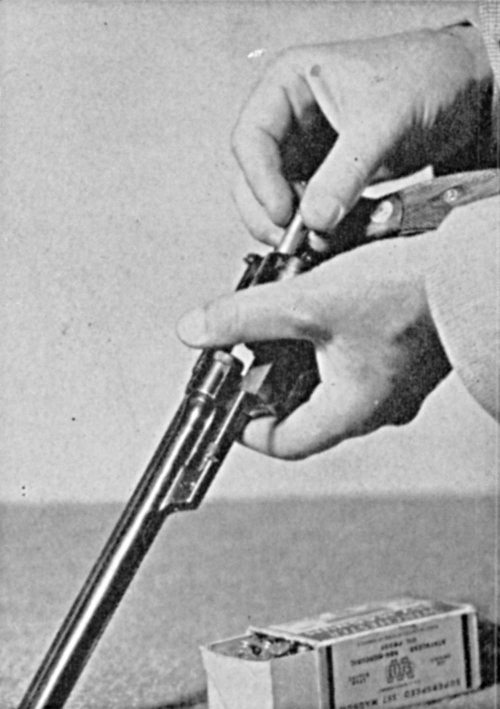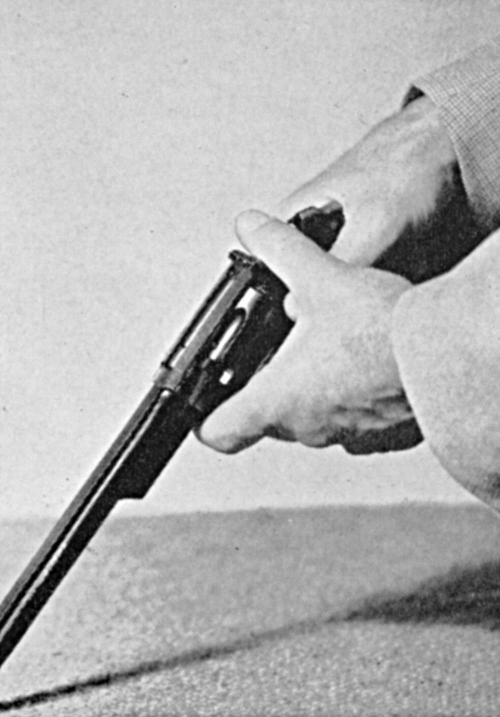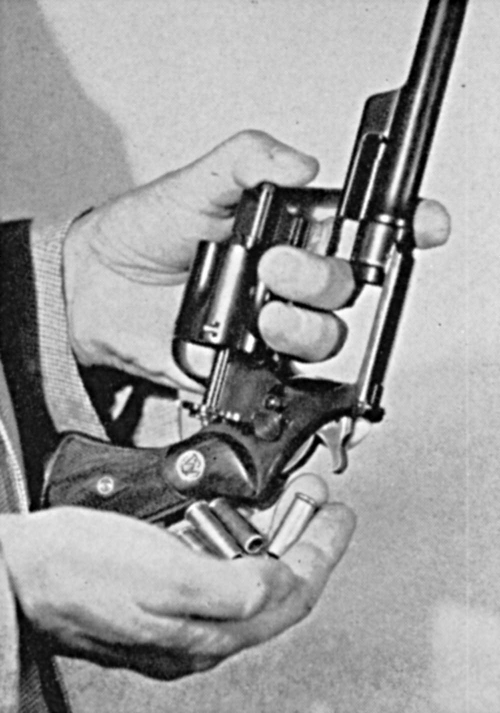The following information on loading and handling a Smith & Wesson revolver comes from Burning Powder by Lt. Col. Douglas B. Wesson. Burning Powder is also available to purchase in print.
The first step in the instruction of shooting must be on the proper handling of the revolver in loading and preparing to fire; “proper” means, of course, Safe. In the following routine it is assumed that the shooter is actually engaged in a shoulder-to-shoulder match with men on each side within three to five feet; here, if anywhere, is the possibility of an accident due to an accidental discharge. The same routine described here should be followed when a shooter is the sole occupant of the firing point until it becomes second nature.
You will stand at the firing point with the arm lying on the bench opened and the correct number of rounds of ammunition beside it. At the command “load,” take the revolver in the left hand (we will assume that you are right-handed) in the position illustrated, with the cylinder uppermost, and held between the thumb and second and third fingers which extend through the cylinder cut in the frame, the revolver is supported by the palm of the hand and the first and fourth fingers on the frame. With the revolver slanting downward and to the left, insert the proper number of rounds and close the cylinder by the pressure of the thumb; do not slap it into place by an abrupt swinging motion of the right hand. We might say here that the somewhat common practice of opening a revolver by pushing forward the thumb piece and snapping the revolver to the left while holding the arm in the right hand, or closing it with a reverse motion by the right hand, in itself is an indication of unfamiliarity with handling fine pieces of mechanism; while in all probability it will not injure the arm, it most certainly throws an unnecessary strain on the yoke and frame, and might result after a considerable length of time in a misalignment of the cylinder and barrel. As an actual matter of fact, this practice is mainly indulged in by people who wish to impress onlookers with their familiarity with hand-guns, but actually establishes an entirely different impression on experienced shooters.
After the gun is closed and transferred to the right hand, the arm is cocked with the right thumb, and while you are getting it properly located in the right hand, using the hold that will be described later on, the hammer is blocked against accidentally applying too much pressure on the trigger (and thereby “slipping a shot”) by the left thumb, as shown in the accompanying illustration. After the proper hold is established, the revolver is then rested on the bench, cocked and ready to fire. Here again if for any reason whatsoever, such as undue nervousness, the trigger should be squeezed, you will note that the bullet will be directed downward and in the direction of the target; no injury can result to the shooter or any of the opponents.
While awaiting the command “start firing,” one will occasionally see a shooter glance toward a friend beside him, or at his back, and in so doing unconsciously swing the revolver around until it will point instead of down the range, directly along the firing line. This is dangerous in the extreme, and such an occurrence would well warrant the Executive Officer ordering that shooter from the firing line and cancelling his entry.
At the command “fire,” the arm will be raised and the proper number of shots fired; if it is Deliberate Fire the cocking of the arm for each shot will be carried on each time as described above; of course in Time or Rapid Fire the arm is not lowered until the string is completed.
After the total number of shots loaded are fired, the arm is opened by pressing forward the thumb piece with the right thumb and pushing the cylinder to the left with the forefinger of the right hand; the arm is then transferred to the left hand in the position as described in loading, pointed upward, as illustrated, and the shells extracted by pressing downward on the extractor rod with the left thumb. It is well to get into the habit of saving the empty shells, as they, as well as the leads which can be recovered from the sandbox beneath the bullet stop, have a salvage value.



